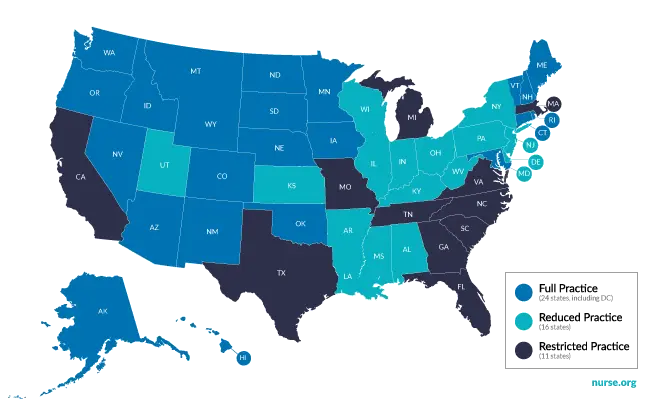2017 was a historic year for Nurse Practitioners with over 20 states voting to
allow full practice authority to NPs. Removing mandatory oversight from
physicians which had hindered NPs being more independent. Physician supervision
has shown to be an expensive and inefficient practice which has hindered growth
for some time. In a time where a shortage of primary care providers has reached
crisis levels, the change is hoped to allow easier access to healthcare to
segments of the population currently being underserved. Prior to the change in
legislation, Nurse Practitioners were required to be affiliated with a physician
who would sign off on orders. A practice that was both costly and in most cases
redundant.The removal of physician oversight helps to reduce costs that had
served as more of a burden than a help. Making it more affordable for NP's to
open practices. These new independent practices are helping to fill gaps left in
our current healthcare landscape. Low-income areas and areas with highest
volumes are expected to see the greatest benefit. [caption
id="attachment_204662" align="alignnone" width="645"] Source:
https://nurse.org/articles/nurse-practitioner-scope-of-practice-expands-mar17/[/caption]
The change hasn't come without opposition. Right now the loudest opposition is
coming from primary care physicians who feel this is an encroachment on their
territory and will hinder patients quality of care. The most common reasoning
being their training or experience isn't enough to provide such care presenting
a liability. In reality, with, NP's taking the brunt of the simpler cases, such
as preventative physician visits, allows more time for physicians to manage more
complex cases. With more people having greater access to healthcare, this model
on paper aims to remove redundancy and reduce costs.
Source:
https://nurse.org/articles/nurse-practitioner-scope-of-practice-expands-mar17/[/caption]
The change hasn't come without opposition. Right now the loudest opposition is
coming from primary care physicians who feel this is an encroachment on their
territory and will hinder patients quality of care. The most common reasoning
being their training or experience isn't enough to provide such care presenting
a liability. In reality, with, NP's taking the brunt of the simpler cases, such
as preventative physician visits, allows more time for physicians to manage more
complex cases. With more people having greater access to healthcare, this model
on paper aims to remove redundancy and reduce costs.
If you've ever gone to visit your physician for anything more than an annual preventative physical, you know a simple 15-minute visit was not nearly enough time to discuss anything in depth. In a recent visit to my primary care physician, there was a sign in the examination room explaining that anything that wasn't preventative would be charged as a separate visit due to the new billing structure. While I could tell the physician was trying his best to be as personal as possible, I could also tell he was pressed for time. The added authority granted to NP's provide an opportunity to bear the brunt of these simpler preventative cases and reserve more time for physicians to handle more complex cases potentially increasing patient's quality of care and satisfaction in the process.

NP's do have a place in primary care and provide a valuable service. What is the right situation? Dr. Davis Liu in his blog relates the change to airline pilots and how they have been trained today. With the rise of flight schools, more pilots are being trained in flight school versus military. He reasons while these pilots are effective in routine situations, they lack the experience to safely deal with more complex situations. Healthcare in America is a state of continuous change. Physicians are in short supply and that shortage is expected to only increase as an expected 3 million Americans turn 65 yearly for the next few 20 years. Now is a time for innovation not competition. Both Nurse Practitioners and physicians are divided on the issue, but both sides need to come together in order to create a solution beneficial to all parties involved. Patients included. What do you think? Lets us know in the comments.
 Source:
https://nurse.org/articles/nurse-practitioner-scope-of-practice-expands-mar17/[/caption]
The change hasn't come without opposition. Right now the loudest opposition is
coming from primary care physicians who feel this is an encroachment on their
territory and will hinder patients quality of care. The most common reasoning
being their training or experience isn't enough to provide such care presenting
a liability. In reality, with, NP's taking the brunt of the simpler cases, such
as preventative physician visits, allows more time for physicians to manage more
complex cases. With more people having greater access to healthcare, this model
on paper aims to remove redundancy and reduce costs.
Source:
https://nurse.org/articles/nurse-practitioner-scope-of-practice-expands-mar17/[/caption]
The change hasn't come without opposition. Right now the loudest opposition is
coming from primary care physicians who feel this is an encroachment on their
territory and will hinder patients quality of care. The most common reasoning
being their training or experience isn't enough to provide such care presenting
a liability. In reality, with, NP's taking the brunt of the simpler cases, such
as preventative physician visits, allows more time for physicians to manage more
complex cases. With more people having greater access to healthcare, this model
on paper aims to remove redundancy and reduce costs. If you've ever gone to visit your physician for anything more than an annual preventative physical, you know a simple 15-minute visit was not nearly enough time to discuss anything in depth. In a recent visit to my primary care physician, there was a sign in the examination room explaining that anything that wasn't preventative would be charged as a separate visit due to the new billing structure. While I could tell the physician was trying his best to be as personal as possible, I could also tell he was pressed for time. The added authority granted to NP's provide an opportunity to bear the brunt of these simpler preventative cases and reserve more time for physicians to handle more complex cases potentially increasing patient's quality of care and satisfaction in the process.

NP's do have a place in primary care and provide a valuable service. What is the right situation? Dr. Davis Liu in his blog relates the change to airline pilots and how they have been trained today. With the rise of flight schools, more pilots are being trained in flight school versus military. He reasons while these pilots are effective in routine situations, they lack the experience to safely deal with more complex situations. Healthcare in America is a state of continuous change. Physicians are in short supply and that shortage is expected to only increase as an expected 3 million Americans turn 65 yearly for the next few 20 years. Now is a time for innovation not competition. Both Nurse Practitioners and physicians are divided on the issue, but both sides need to come together in order to create a solution beneficial to all parties involved. Patients included. What do you think? Lets us know in the comments.






